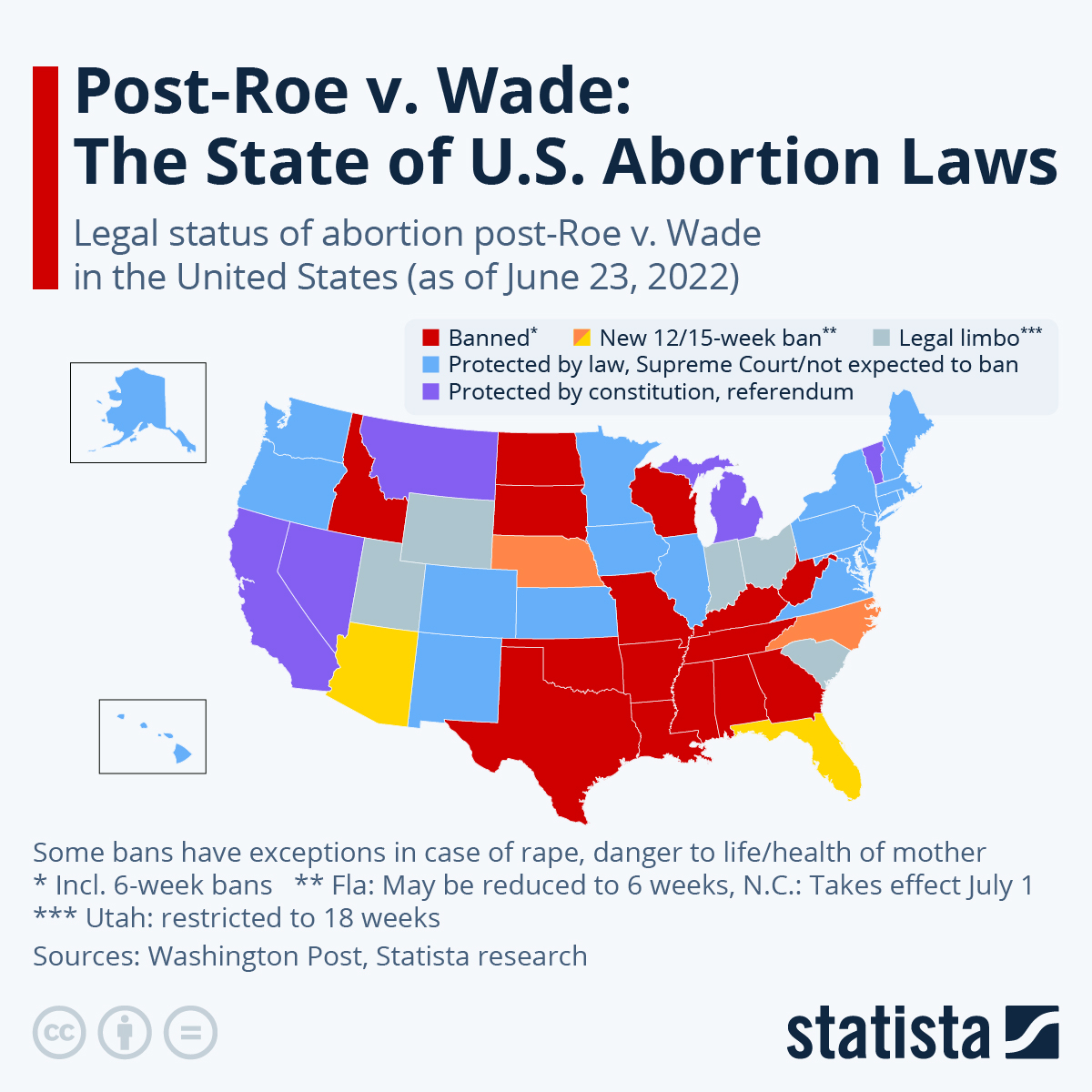
Despite the extreme sound and fury, legal abortions have fallen about 3% nationwide in the year since the Supreme Court overturned Roe v. Wade, according to Axios.
Between April 2022 and March 2023, the number of monthly abortions performed in the United States decreased by an average of around 2,850 following the ban or restriction of the procedure.
As Statista's Katharina Buchholz details below, 15 states have banned most abortions or have limited them to 6-weeks of gestation, a time when many pregnancies still go undetected. Four more states have restricted abortions to 12 to 15 weeks, which is when a large majority of abortions occur. While five states are still in legal limbo, 27 continue to allow abortions up to the fetal viability limit formerly defined by Roe, at around 23 to 25 weeks. Most recently, a 6-week ban in Iowa failed in front of the state's Supreme Court and the tightening of bans is still expected in Arizona and Florida, among others.
You will find more infographics at Statista
Most of the 27 states guarantee these rights through state laws or state Supreme Court decisions. State constitutional amendments or referendums on abortions, which are harder to overturn, are actually quite rare in the U.S., as Statista's graphic shows.
States which have not banned or restricted abortions despite not protecting them in any way are Democrat-led New Mexico, Republican-led New Hampshire as well as Virginia and Pennsylvania, which have split governments.
Data from activist group Society of Family Planning shows safe haven locations that some abortions have shifted to following the decision.
You will find more infographics at Statista
Illinois and Florida emerged as the biggest of such safe haven states as of March. Around 1,400 more monthly abortions per state were performed on average between June and March compared to April 2022, before Roe was overturned. Florida saw this increase despite a ban on abortions after 15 weeks that came into effect on July 1, as states in its vicinity passed even harsher restrictions. Governor Ron DeSantis has already signed a law that prohibits abortions after 6 weeks of gestation, but it will only come into effect once a court case around the first ban has been resolved. If the 6-week ban would start to be enforced, this would shift and potentially decrease abortions again as many pregnancies go undetected until that stage.
Another state that saw monthly abortion numbers go up since April 2022 was North Carolina (+881) - likely due to its vicinity to Georgia, where almost 1,800 fewer abortions were performed per month on average. A new ban on abortions after 12 weeks comes into effect in North Carolina on July 1. But like in the case of Florida, this might only change the number slightly as 93 percent of U.S. abortions are performed at or before 13 weeks. Colorado saw an average monthly increase of 500 abortions, while Kansas and Virginia saw around 350 more per month.
However, shifts in abortions did not make up for overall decreases. Abortions were outlawed or heavily restricted in some populous states which led to more than 1,000 fewer taking place every month in Georgia, but also in Texas (-2,593) and Tennessee (-1,122). The makers of the report point out that traveling to receive an abortion is not a new phenomenon as access to the procedure and the laws around it varied widely in the U.S. even before the overturning of Roe v. Wade. In 2020, an average of 9 percent of those receiving an abortion already traveled out of state. The report also says that due to the now increased travel activity and a concentration on some states, longer wait times for abortions occurred in 2022 and 2023.
Despite the extreme sound and fury, legal abortions have fallen about 3% nationwide in the year since the Supreme Court overturned Roe v. Wade, according to Axios.
Between April 2022 and March 2023, the number of monthly abortions performed in the United States decreased by an average of around 2,850 following the ban or restriction of the procedure.
As Statista’s Katharina Buchholz details below, 15 states have banned most abortions or have limited them to 6-weeks of gestation, a time when many pregnancies still go undetected. Four more states have restricted abortions to 12 to 15 weeks, which is when a large majority of abortions occur. While five states are still in legal limbo, 27 continue to allow abortions up to the fetal viability limit formerly defined by Roe, at around 23 to 25 weeks. Most recently, a 6-week ban in Iowa failed in front of the state’s Supreme Court and the tightening of bans is still expected in Arizona and Florida, among others.
You will find more infographics at Statista
Most of the 27 states guarantee these rights through state laws or state Supreme Court decisions. State constitutional amendments or referendums on abortions, which are harder to overturn, are actually quite rare in the U.S., as Statista’s graphic shows.
States which have not banned or restricted abortions despite not protecting them in any way are Democrat-led New Mexico, Republican-led New Hampshire as well as Virginia and Pennsylvania, which have split governments.
Data from activist group Society of Family Planning shows safe haven locations that some abortions have shifted to following the decision.
You will find more infographics at Statista
Illinois and Florida emerged as the biggest of such safe haven states as of March. Around 1,400 more monthly abortions per state were performed on average between June and March compared to April 2022, before Roe was overturned. Florida saw this increase despite a ban on abortions after 15 weeks that came into effect on July 1, as states in its vicinity passed even harsher restrictions. Governor Ron DeSantis has already signed a law that prohibits abortions after 6 weeks of gestation, but it will only come into effect once a court case around the first ban has been resolved. If the 6-week ban would start to be enforced, this would shift and potentially decrease abortions again as many pregnancies go undetected until that stage.
Another state that saw monthly abortion numbers go up since April 2022 was North Carolina (+881) – likely due to its vicinity to Georgia, where almost 1,800 fewer abortions were performed per month on average. A new ban on abortions after 12 weeks comes into effect in North Carolina on July 1. But like in the case of Florida, this might only change the number slightly as 93 percent of U.S. abortions are performed at or before 13 weeks. Colorado saw an average monthly increase of 500 abortions, while Kansas and Virginia saw around 350 more per month.
However, shifts in abortions did not make up for overall decreases. Abortions were outlawed or heavily restricted in some populous states which led to more than 1,000 fewer taking place every month in Georgia, but also in Texas (-2,593) and Tennessee (-1,122). The makers of the report point out that traveling to receive an abortion is not a new phenomenon as access to the procedure and the laws around it varied widely in the U.S. even before the overturning of Roe v. Wade. In 2020, an average of 9 percent of those receiving an abortion already traveled out of state. The report also says that due to the now increased travel activity and a concentration on some states, longer wait times for abortions occurred in 2022 and 2023.
Loading…






